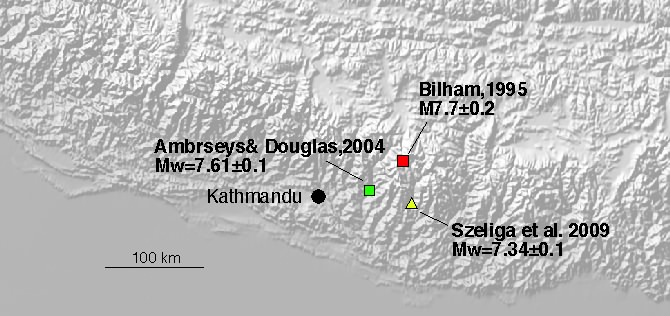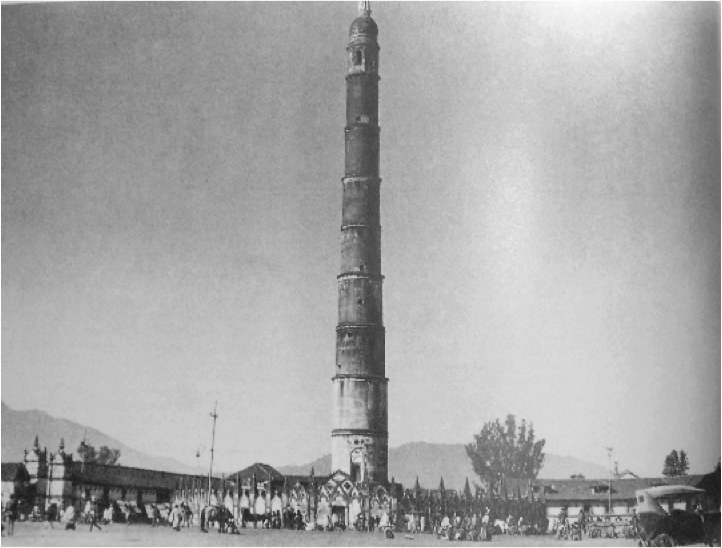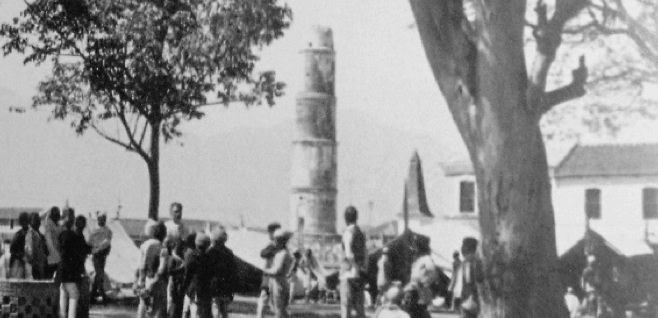26 August 1833 Nepal
The earthquake damaged Kathmandu, and although it was felt in Chittagong to the SE and Delhi to the SW it was hardly felt in Lhasa to the north. Three shocks occurred with increasing magnitude. Its magnitude has been assessed at 7.3<Mw<7.7.The earthquake is mentioned in T. Oldham (1883), and the felt-area isoseismal contour was first drafted by R. D. Oldham (1899). These were repeated in Dunn et al., (1935) in the report on the 1934 Bihar Nepal earthquake. It is probable that the rupture area of the 1833 earthquake was contiguous with the NW edge of the 1934 Mw8.1 rupture, but the rupture areas of neither earthquake are known for certain. The 2015 earthquake ruptured part of the same area again.
Intensity data
Observations of intensities in the earthquake in comtemporary newspapers and letters were reproduced by Bilham (1995) and expanded by Ambraseys and Douglas (2003) andby Martin and Szeliga (2009), who itemize more than sixty locations where intensity was observed. See tables of felt intensity, for locations where intensities have been assigned and for comparisons between 1934 and 1833.The international organisation GEM has independently evaluated the earthquake and places its epicenter to the west of Kathmandu.

The figure illustrates three estimates for the epicenter of the 1833 mainshock (see table below). Bilham (1995) used an elliptical contouring method, Ambraseys and Douglas (2004) used contoured kriging, and Szeliga et al., 2009 used a modified version of Bakun and Wentworth, (1997) to demonstrate that the method gave absurd results.
Table 1. 1833 Epicentral Parameters Mw=7.5+-0.2
| lat N | long E | Mw | uncertainty | source |
| 28.0 | 86.0 | 7.7 | 0.2 | Bilham, 1995 |
| 27.7 | 85.7 | 7.61 | 0.1 | Ambraseys & Douglas, 2004 |
| 27.55 | 85.11 | 7.3 | 0.1 | Szeliga et al., 2009 |
Despite the good agreement between the three estimates of epicentral location (all within one rupture dimension) the agreement should not be taken to signify accuracy, since the solutions are clearly biased by the absence of data to the east. The magnitude shows a spread of a factor of 3-4 in equivalent rupture dimension or slip. The low magnitude calculated by Szeliga et al may be unduly reduced by their choice of Himalayan attenuation. They calculate that the two foreshocks were close to the source zone of the mainshock with magnitudes of 5.1 and 6.5 respectively, however, the method of Bakun And Wentworth results in unacceptable solutions without manipulation of the input data.
The foreshock/aftershock sequence suggests that the rupture sequence was complex and that more than one fault was active, For this reason it is unlikely that we will be able to determine the rupture parameters of this historical earthquake with much greater precision than we do at present.
References
Ambraseys, N., and J. J. Douglas (2004), Magnitude calibration of
north Indian earthquakes, Geophys. J. Int., 159, 165–206, doi:10.1111/
j.1365-246X.2004.02323.x.
Bilham, R., Location and magnitude of the 1833 Nepal earthquake and its relation to the rupture zones of contiguous great Himalayan earthquakes, pdf Current Science, 69(2), 101-128, 1995.
Bakun, W.H. & Wentworth, C.M., 1997. Estimating earthquake location
and magnitude from seismic intensity data, Bull. seism. Soc. Am., 87(6),
1502–1521.
Dunn, J.A., Auden, J.B., Ghosh, A.M. & Wadia,D.N., 1939. The Bihar-Nepal earthquake of 1934, Mem. Geol. Surv. India, 73, 1–391.
Martin, S., and W. Szeliga, A catalog of felt intensity data for 589 earthquakes in India, 1636–2008, Bull. Seismol. Soc. Am.
Oldham, R., 1899. Report on the great earthquake of 12th June 1897, Mem.
Geol. Surv. India, 29.
Szeliga, W., S. Hough, S. Martin, R. Bilham, Intensity, magnitude, location and attenuation in India for felt earthquakes since 1762, Bull. Seism. Soc. Amer., 2009.

The 10-storey Bhim Sen tower (c. 1930) was constructed in 1825 (one of two according to Campbell - see panel left ) and was reconstructed in 1836 after being destroyed by the 1833 earthquake. It lost its uppermost 5 stories in 1934 (see below) . It stood, reconstructed in 1936, awaiting the next shock which occurred 25 April 2015. Desctruction in 2015 was total.

 Brian Hodgson (1801-1894) was the British resident at the time, and he most certainly would have written about the earthquake since he was an observant man, dedicated to the study of science, Himalayan languages and the Bhuddist religion. However, in his letter to his sisters shortly after the earthquake he makes no comment on it, and no note on the earthquake has been found from him in administrative records. Instead, much that we know of the epicentral damage comes from Alexander Campbell the physician to the British Residency in Kathmandu.
Brian Hodgson (1801-1894) was the British resident at the time, and he most certainly would have written about the earthquake since he was an observant man, dedicated to the study of science, Himalayan languages and the Bhuddist religion. However, in his letter to his sisters shortly after the earthquake he makes no comment on it, and no note on the earthquake has been found from him in administrative records. Instead, much that we know of the epicentral damage comes from Alexander Campbell the physician to the British Residency in Kathmandu.